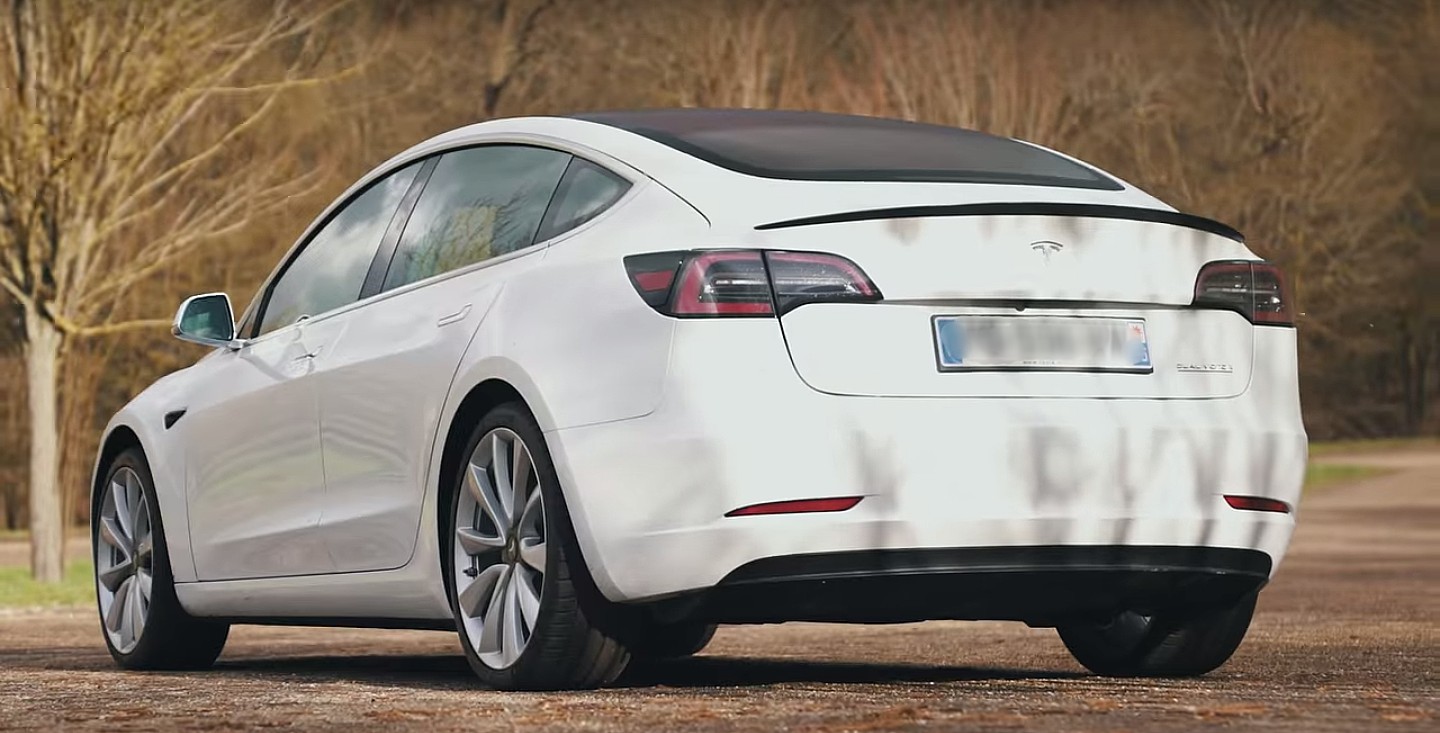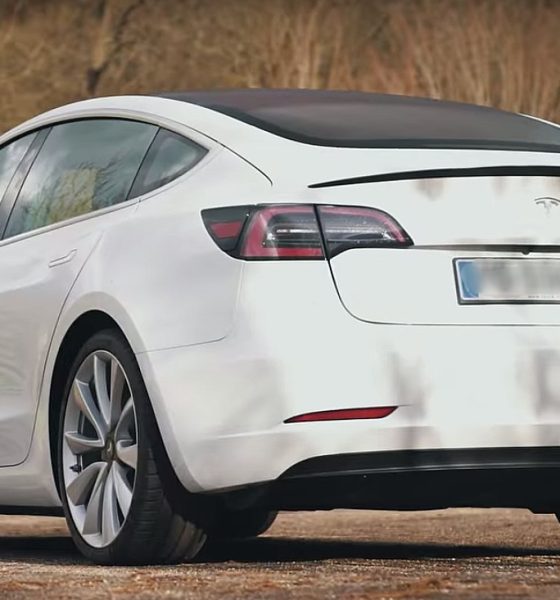

News
Tesla Model 3 dominates UK, sells more units than 2nd and 3rd most popular EVs combined
An automotive dealer magazine in the United Kingdom recently released statistics that name the Tesla Model 3 as the most popular electric car in the region in April 2020, and it was not a close race.
The Model 3 shone in the UK in the first month of Q2, outselling the Jaguar I-Pace and Vauxhall Corsa by a considerable margin. In fact, if one were to combine the number of units sold of the I-Pace (367) and the Corsa (264), the number would still be less than the number of Tesla Model 3 sold (658).
The Model 3 Standard Range+ starts at about £35,000 in the UK while offering 465 kilometers, or 288 miles of range under WLTP standards. Meanwhile, the I-Pace’s range is rated for 470 kilometers, or 292 WLTP miles in the UK, and its starting price is £64,495. The Corsa is the most affordable of the three with a starting pricing point of £26,990, but it only offers 330 kilometers, or 205 miles of range.
The figures appeared on Car Dealer Magazine, a United Kingdom-based automotive publication that is sent to 10,000 UK-located dealerships every month. The magazine wrote highly of the Model 3, while highlighting the fact that the automotive industry has taken more than a 97% drop compared to April 2019 due to the ongoing pandemic.
Car Dealer Magazine wrote, “It was – somewhat predictably – a dismal month for sales of new cars, with the SMMT today announcing a 97.3 percent drop on April 2019, but sales there still were – and the Tesla Model 3 shot to the top of the table with 658 units.”
The Model 3’s presence in the UK has been notable in the past. In late 2019, a trade association had announced that diesel vehicle sales had been dropping while battery electric vehicle (BEV) sales had increased by over 228%. This charge by BEVs was led by the Model 3, which had not only become the best-selling electric vehicle in the UK but the third highest-selling vehicle in the region regardless of propulsion.
The Model 3 has picked up several awards in the UK, which include “Car of the Year,” “Best Electric Car,” “Best Company Car,” and “Best Safety” awards from the prestigious automotive magazine Parker’s Car Guides. Writers and reviewers at Parker’s called the Model 3 a “capable, likable, and extremely good to drive” vehicle.
However, the Model 3’s dominance goes far beyond the UK.
Across the globe, the slowing automotive market has affected nearly every country that records automobile sales. In China, March was perhaps the most impressive month for the Model 3. After the registrations of Tesla’s most affordable sedan slumped to just over 2,300 in February, a 450% increase occurred in March, even though the entire auto industry was slowing down by over 43%.
The Model 3 continues to prove its dominance across different countries. Even in tough times for the automotive market as a result of the COVID-19 pandemic, the Model 3 has shown an uptrend in sales in some countries. The electric sedan has remained the “top dog” in other locations thanks to affordability, performance, and range.

Elon Musk
Elon Musk and Tesla AI Director share insights after empty driver seat Robotaxi rides
The executives’ unoccupied tests hint at the rapid progress of Tesla’s unsupervised Robotaxi efforts.

Tesla CEO Elon Musk and AI Director Ashok Elluswamy celebrated Christmas Eve by sharing personal experiences with Robotaxi vehicles that had no safety monitor or occupant in the driver’s seat. Musk described the system’s “perfect driving” around Austin, while Elluswamy posted video from the back seat, calling it “an amazing experience.”
The executives’ unoccupied tests hint at the rapid progress of Tesla’s unsupervised Robotaxi efforts.
Elon and Ashok’s firsthand Robotaxi insights
Prior to Musk and the Tesla AI Director’s posts, sightings of unmanned Teslas navigating public roads were widely shared on social media. One such vehicle was spotted in Austin, Texas, which Elon Musk acknowleged by stating that “Testing is underway with no occupants in the car.”
Based on his Christmas Eve post, Musk seemed to have tested an unmanned Tesla himself. “A Tesla with no safety monitor in the car and me sitting in the passenger seat took me all around Austin on Sunday with perfect driving,” Musk wrote in his post.
Elluswamy responded with a 2-minute video showing himself in the rear of an unmanned Tesla. The video featured the vehicle’s empty front seats, as well as its smooth handling through real-world traffic. He captioned his video with the words, “It’s an amazing experience!”
Towards Unsupervised operations
During an xAI Hackathon earlier this month, Elon Musk mentioned that Tesla owed be removing Safety Monitors from its Robotaxis in Austin in just three weeks. “Unsupervised is pretty much solved at this point. So there will be Tesla Robotaxis operating in Austin with no one in them. Not even anyone in the passenger seat in about three weeks,” he said. Musk echoed similar estimates at the 2025 Annual Shareholder Meeting and the Q3 2025 earnings call.
Considering the insights that were posted Musk and Elluswamy, it does appear that Tesla is working hard towards operating its Robotaxis with no safety monitors. This is quite impressive considering that the service was launched just earlier this year.
Elon Musk
Starlink passes 9 million active customers just weeks after hitting 8 million
The milestone highlights the accelerating growth of Starlink, which has now been adding over 20,000 new users per day.

SpaceX’s Starlink satellite internet service has continued its rapid global expansion, surpassing 9 million active customers just weeks after crossing the 8 million mark.
The milestone highlights the accelerating growth of Starlink, which has now been adding over 20,000 new users per day.
9 million customers
In a post on X, SpaceX stated that Starlink now serves over 9 million active users across 155 countries, territories, and markets. The company reached 8 million customers in early November, meaning it added roughly 1 million subscribers in under seven weeks, or about 21,275 new users on average per day.
“Starlink is connecting more than 9M active customers with high-speed internet across 155 countries, territories, and many other markets,” Starlink wrote in a post on its official X account. SpaceX President Gwynne Shotwell also celebrated the milestone on X. “A huge thank you to all of our customers and congrats to the Starlink team for such an incredible product,” she wrote.
That growth rate reflects both rising demand for broadband in underserved regions and Starlink’s expanding satellite constellation, which now includes more than 9,000 low-Earth-orbit satellites designed to deliver high-speed, low-latency internet worldwide.
Starlink’s momentum
Starlink’s momentum has been building up. SpaceX reported 4.6 million Starlink customers in December 2024, followed by 7 million by August 2025, and 8 million customers in November. Independent data also suggests Starlink usage is rising sharply, with Cloudflare reporting that global web traffic from Starlink users more than doubled in 2025, as noted in an Insider report.
Starlink’s momentum is increasingly tied to SpaceX’s broader financial outlook. Elon Musk has said the satellite network is “by far” the company’s largest revenue driver, and reports suggest SpaceX may be positioning itself for an initial public offering as soon as next year, with valuations estimated as high as $1.5 trillion. Musk has also suggested in the past that Starlink could have its own IPO in the future.
News
NVIDIA Director of Robotics: Tesla FSD v14 is the first AI to pass the “Physical Turing Test”
After testing FSD v14, Fan stated that his experience with FSD felt magical at first, but it soon started to feel like a routine.

NVIDIA Director of Robotics Jim Fan has praised Tesla’s Full Self-Driving (Supervised) v14 as the first AI to pass what he described as a “Physical Turing Test.”
After testing FSD v14, Fan stated that his experience with FSD felt magical at first, but it soon started to feel like a routine. And just like smartphones today, removing it now would “actively hurt.”
Jim Fan’s hands-on FSD v14 impressions
Fan, a leading researcher in embodied AI who is currently solving Physical AI at NVIDIA and spearheading the company’s Project GR00T initiative, noted that he actually was late to the Tesla game. He was, however, one of the first to try out FSD v14.
“I was very late to own a Tesla but among the earliest to try out FSD v14. It’s perhaps the first time I experience an AI that passes the Physical Turing Test: after a long day at work, you press a button, lay back, and couldn’t tell if a neural net or a human drove you home,” Fan wrote in a post on X.
Fan added: “Despite knowing exactly how robot learning works, I still find it magical watching the steering wheel turn by itself. First it feels surreal, next it becomes routine. Then, like the smartphone, taking it away actively hurts. This is how humanity gets rewired and glued to god-like technologies.”
The Physical Turing Test
The original Turing Test was conceived by Alan Turing in 1950, and it was aimed at determining if a machine could exhibit behavior that is equivalent to or indistinguishable from a human. By focusing on text-based conversations, the original Turing Test set a high bar for natural language processing and machine learning.
This test has been passed by today’s large language models. However, the capability to converse in a humanlike manner is a completely different challenge from performing real-world problem-solving or physical interactions. Thus, Fan introduced the Physical Turing Test, which challenges AI systems to demonstrate intelligence through physical actions.
Based on Fan’s comments, Tesla has demonstrated these intelligent physical actions with FSD v14. Elon Musk agreed with the NVIDIA executive, stating in a post on X that with FSD v14, “you can sense the sentience maturing.” Musk also praised Tesla AI, calling it the best “real-world AI” today.








